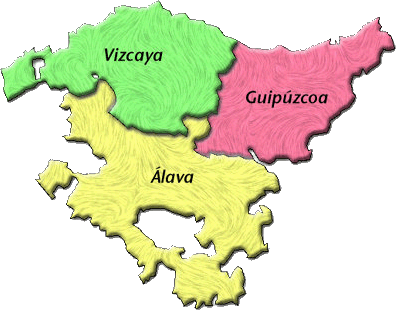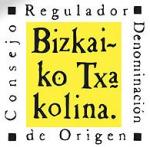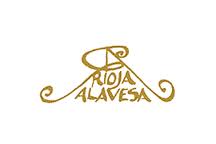Basque Country DOs

Wine in the Basque Country (País Vasco in Spanish; Euskadi in Basque) is divided into two main categories: Txakoli (also spelled Chacoli, Txacoli or Chakoli), which is the traditional Basque wine; and the wines from the Rioja Alavesa, which produces wines under the DOCa of Rioja. Txakoli has been a part of the Basque culture for many years.
Until the 1980s, txakoli was home-made in farmhouses. The fist documented trade of txakoli dates from the 16th century in Guipúzcoa, and later documents state that this Basque wine was traded in all of the Basque Country, Cantabria and Valle de Mena. During the phylloxera plague of the 19th century, txakoli almost died out, but the Basques are so zealous of their culture that they did everything in their power to keep the production going. Finally, their efforts were rewarded when three production areas obtained the DO category in the 90s.
In recent years, txakoli has acquired quite a fame. This is mostly due to the high quality of the products, but another reason for its recent spread is that it adequates very well to the actual wine trends: it's light, cold and fruity, and so easy to drink you'll be finishing the bottle before you know it. Txakoli normally accompanies fish, sea food and rare meat, but it's also very common to drink it with pintxos (the Basque tapas). Its cool flavor, paired with a fresh pintxo of hake, will make you wish you could spend more summers in Spain so you don't ever have to stop drinking it!
DO (designations of origin) of the Basque Country
There are 3 designations of origin which produce txakoli in the Basque Country, but it's also produced in Cantabria and in Burgos. In fact, when the Basque Government tried in 2010 to limit txakoli production to the Basque Country, there was an uproar from the producers in Burgos, who argued that txakoli had been produced in Burgos for over 10 centuries.
White txakoli is the most common variety, although there are small productions of red and rosé. White txakoli is a pale yellow color, it's served cold and from a distance (like the cider in Asturias) in a low, wide glass and should be drunk before the bubbles are gone. Txakoli doesn't keep for more than a year in the bottle, so be sure to drink it before then! Drinking txakoli in the Basque country is the most typical thing to do and will guarantee you a total Spanish immersion.
DO Arabako Txakolina

DO Arabako Txakolina (Chacoli de Alava in Spanish) is a designation of origin located in the Alava province. Established in 2001, it's the youngest of all the Basque DO. In Alava there is also a big production of Rioja wine, which has parts of its vineyards in the south of the province. The txakoli vineyards are to the north, right beside the border of Alava with the Vizcaya province. The climate in the area is influenced by the Atlantic ocean, with cool summers and cold winters with dangers of frost and sometimes hail.
The grape varieties accepted by DO Arabako Txakolina are Hondarribi Zuri, Gross Manseng, Petit Manseng and Petit Corbu in whites, and Hondarribi Beltza in reds (txakoli is generally white, but there are also small productions of red and rosé txakoli). The alcohol content in txakoli produced by DO Arabako Txakolina is 9.5%
DO Bizkaiko Txakolina

DO Bizkaiko Txakolina (Chacoli de Vizcaya in Spanish) is located in the Vizcaya province, in the north of the Basque Country. It was established in 1994. This was a great victory for the Vizcaya producers, because although txakoli is a fairly popular drink, during the 19th century the production suffered great losses due to the phylloxera plague and other social and economic factors, and almost died out. However, during the 1980s a group of producers were determined to bring back the old txakoli customs and they were finally rewarded with the establishment of the DO.
Most of the DO Bizkaiko Txakolina vineyards are in the north of the Basque Country, close to Bilbao (the capital) and the coast, but there are other plantations farther from the coast. Vines are planted at around 500 feet of altitude and they're affected by an Atlantic climate in the coast, cool and humid; and a continental climate in the inner plantations, dryer and warmer. The allowed grape varieties are Hondarribi beltza in reds and Hondarribi zuri, Folle blanche, Gros Manseng and Petit Manseng in whites.
DO Getariako Txakolina

DO Getariako Txakolina (Chacolí de Guetaria in Spanish language) was established in 1989, making it the oldest designation of origin regarding txakoli. The vineyards are located in the north of the Guipúzcoa province, close to the coast and planted in slopes facing away from the sea to protect them from the strong nautical breezes and to make sure they get enough sun. The accepted grape varieties are Hondarribi Beltza in reds and Hondarribi Zuri in whites.
DOCa Rioja Alavesa

DOCa Rioja Alavesa is a sub zone of DOCa Rioja that has it's vineyards in south of the Basque Country. The vineyards are planted right on the shore of the Ebro river, at 1150-1600 feet of altitude where they benefit from many hours of sun exposure. Around 80% of the plantation is composed of Tempranillo grape, with another 4% dedicated to red grapes and the rest to several varieties of white grape.
Spanish Wine History
Spanish Wine Regions and DO
Spanish Wine Tours
Top Spanish designations of origin
Best Spanish Wines
Spanish Wine Production
Spanish Wine Types
Spanish Grapes
Spanish Sparkling Wine: Cava
Sherry Wine
Spanish Wine Cocktails
Spanish Wines in the World
Spanish Wine Prizes
Enotourism
Spanish spirits and liquors
Argentina Wines
Chilean Wines
Other sites